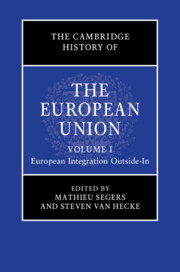Book contents
- The Cambridge History of the European Union
- The Cambridge History of the European Union
- The Cambridge History of the European Union
- Copyright page
- Contents
- Figures
- Contributors to Volume I
- Acknowledgements
- Abbreviations
- Reflections on the History and Historiography of European Integration
- Part I Critical Junctures
- Part II Multilateralism and Geopolitics
- Market, Society and Security
- 7 A Pillar of the Golden Age? European Integration and the Trente Glorieuses
- 8 The End of Bretton Woods: Origins and European Consequences
- 9 The Vicissitudes of Market Europe
- 10 European Integration and the Challenges of Free Movement
- 11 The EU as a Global Trade Power
- 12 The Enduring Relationship between NATO and European Integration
- Global Challenges: International Politics, the Planet and the Universe
- Part III Perspectives and Ideas
- Index
- References
8 - The End of Bretton Woods: Origins and European Consequences
from Market, Society and Security
Published online by Cambridge University Press: 21 October 2023
- The Cambridge History of the European Union
- The Cambridge History of the European Union
- The Cambridge History of the European Union
- Copyright page
- Contents
- Figures
- Contributors to Volume I
- Acknowledgements
- Abbreviations
- Reflections on the History and Historiography of European Integration
- Part I Critical Junctures
- Part II Multilateralism and Geopolitics
- Market, Society and Security
- 7 A Pillar of the Golden Age? European Integration and the Trente Glorieuses
- 8 The End of Bretton Woods: Origins and European Consequences
- 9 The Vicissitudes of Market Europe
- 10 European Integration and the Challenges of Free Movement
- 11 The EU as a Global Trade Power
- 12 The Enduring Relationship between NATO and European Integration
- Global Challenges: International Politics, the Planet and the Universe
- Part III Perspectives and Ideas
- Index
- References
Summary
In July 1944, delegations from forty-five nations gathered at the Mount Washington Hotel in Bretton Woods to devise a monetary regime for the post-war world that aimed to replace the currency warfare of the 1930s and to provide a firm basis for the restoration of a multilateral world economy. Between 1971 and 1973, this system fell apart – and during the fruitless attempts at reform, the European Economic Community (EEC) took initial steps to move from the customs union and Common Agricultural Policy (CAP) to monetary union. This shift in priorities is usually explained as an internal European process, but this chapter indicates that it needs to be understood within a wider context of the design flaws of the Bretton Woods system, failed reform by the International Monetary Fund (IMF) and growing European criticism of the American response.
- Type
- Chapter
- Information
- The Cambridge History of the European Union , pp. 209 - 234Publisher: Cambridge University PressPrint publication year: 2023

